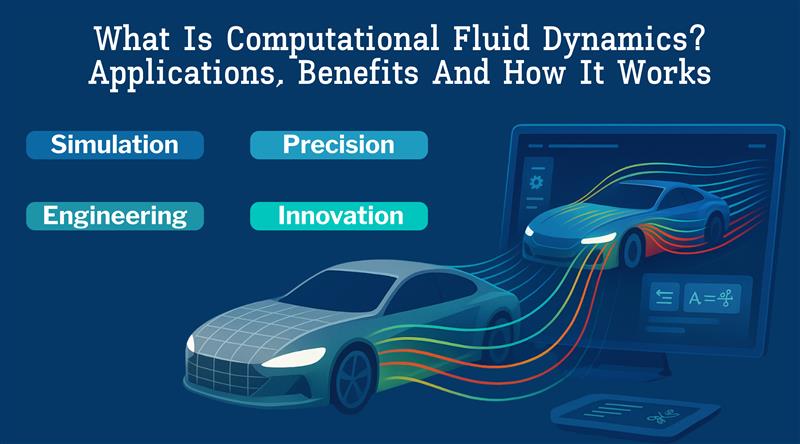Are you ready to unlock the hidden power of fluid flow in your engineering projects? Computational Fluid Dynamics (CFD) might just be the game changer you’ve been searching for.
This powerful tool helps engineers visualize, simulate, and optimize fluid dynamics with staggering accuracy saving time, money and guesswork. In this post, we’ll explore why CFD matters, how it works and how it can transform your next innovation.
What Is Computational Fluid Dynamics?
Computational Fluid Dynamics is the science of using numerical methods and algorithms to solve problems involving fluid flows. Instead of relying solely on physical experiments, CFD allows you to model and analyze how liquids and gases behave under various conditions right on your screen.
Why Use CFD Over Traditional Methods?
- Cost-efficiency: No need for multiple costly prototypes. CFD simulates conditions in a virtual environment.
- Speed: Instant visualization replaces long testing cycles.
- Flexibility: Simulate extreme or dangerous environments safely.
- Insight: Gain deep insight into pressure distributions, turbulence, heat transfer, and more.
How CFD Works: The Basics
1. Pre processing
Define the geometry, mesh, boundary conditions, and fluid properties. Think of the mesh as the grid where the physics will unfold.
2. Solver Phase
The software applies the Navier–Stokes equations fundamental laws governing fluid motion. The solver calculates fluid pressure, velocity, temperature, and other parameters.
3. Post-processing
Visualize the results using streamlines, pressure contours, and temperature maps. This is where decisions are made adjust geometry, refine mesh, rerun simulations.
Applications of Computational Fluid Dynamics in the Real World
Aerospace & Automotive
Design sleek, efficient aircraft and vehicles. CFD helps reduce drag and improve fuel economy with minimal wind tunnel testing.
Energy & HVAC
Optimize turbine efficiency, solar collectors, and heating, ventilation, and air-conditioning systems. CFD ensures your designs deliver performance where it matters most.
Civil & Environmental Engineering
Model wind loads on buildings, dispersion of pollutants, or water flow in flood scenarios. CFD empowers safer, more resilient infrastructure.
Medical & Bioengineering
From blood flow in arteries to airflow in medical devices, CFD plays a critical role in healthcare innovation.
Best Practices to Improve CFD Outcomes
Mesh Quality Matters
A finely resolved mesh in high-gradient regions reduces errors and delivers sharper results.
Validate Your Simulations
Always cross-check CFD results with experimental or benchmark data to ensure credibility.
Use Appropriate Models
Select turbulence or multiphase models that accurately represent complex flows. Choose wisely each model carries assumptions.
Automate Where Possible
Embrace scripting and automation tools to streamline repetitive CFD tasks like mesh generation and batch simulations.
Common Challenges and How to Overcome Them
1. High Computational Cost
CFD simulations can be resource-hungry. Use adaptive mesh refinement and cloud-based HPC solutions to manage workload.
2. Convergence Problems
Iterative solvers sometimes struggle to stabilize. Tweak relaxation factors, initial guesses, or boundary conditions to iron out issues.
3. Interpreting Complex Results
CFD outputs vast amounts of data. Focus on critical parameters pressure drop, heat flux, drag coefficient and visualize them effectively.
The Future of Computational Fluid Dynamics
CFD software is getting smarter. Expect advances like real-time simulation, AI-driven turbulence models, and more seamless integration with CAD systems. As these tools improve, CFD accessibility increases, enabling engineers at every level to innovate faster.
Getting Started with CFD
If you’re new to the field, try these steps:
- Choose the right software: Entry-level tools like OpenFOAM or commercial suites like ANSYS Fluent or COMSOL Multiphysics.
- Learn the fundamentals: Familiarize yourself with fluid mechanics, numerical methods, and computational basics.
- Start small: Begin with simple flows to build confidence before tackling complex applications.
- Join communities: Online forums, webinars and user groups offer practical tips and peer support.
If you’re a PhD researcher delving into the complexities of Computational Fluid Dynamics, our expert research assistant are here to support you at every stage of your journey. Whether you need help refining your methodology, interpreting simulation results, or managing large datasets, we offer tailored guidance to ensure your research is accurate, efficient, and publication ready.
Partner with us to streamline your CFD research and focus on what truly matters making impactful contributions to your field. Get in touch today and let’s accelerate your research together.
FAQs
1. What’s the difference between CFD and traditional wind tunnel testing?
CFD is a virtual simulation; wind tunnels are physical experiments. You can test various conditions more quickly and at a lower cost, and then validate with wind tunnel tests if needed.
2. Is Computational Fluid Dynamics only for experts?
While CFD has a learning curve, modern software with intuitive interfaces and community resources makes it accessible to engineers at all levels.
3. Can CFD replace all experimental testing?
Not entirely. CFD excels in screening and optimization. Critical or certified designs still benefit from validation via physical testing.
4. What skills do I need to be good at CFD?
You’ll need a good grasp of fluid mechanics, numerical methods, boundary conditions, mesh generation, and data interpretation.
5. How long does it take to learn CFD?
With focused study and practice, you can become proficient in 3–6 months. Expertise grows over years, especially as you tackle complex, real-world problems.





Comments